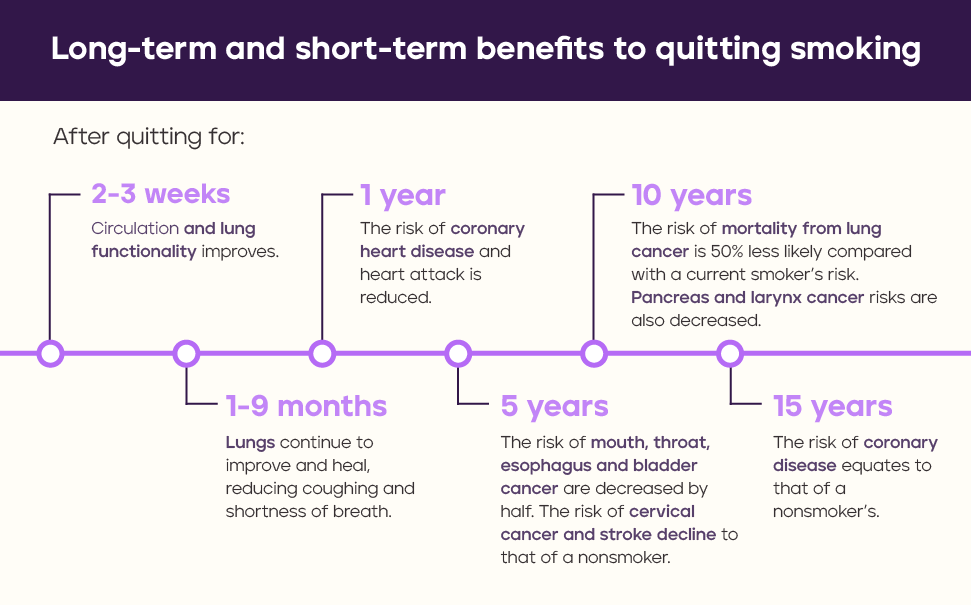Smoking vs. vaping. Dual use. Continuum of risk.
If these terms have you confused about what to recommend to your employees or health plan members who smoke, read on.
What happens when you quit smoking cigarettes
Smoking remains the leading cause of preventable death. Quitting smoking is the most important step someone can take to protect their health. In addition to reducing the risk of death, quitting smoking has many other short and long-term health benefits, some of which may surprise you.
For example, here are some of the effects on your body after you quit smoking:
- After quitting for 2 weeks, circulation and lung functionality improve.
- After 1 year, the risks of coronary heart disease and heart attack are reduced.
- After 5 years, the risk of a variety of cancers is reduced, and the risk of stroke declines to that of a nonsmoker.
- After 10 years, the risk of dying from lung cancer is 50% less likely compared to a current smoker.
- After 15 years, the risk of coronary disease equates to that of a nonsmoker’s.
Quitting smoking also has benefits for kidneys, mental health, obesity, hearing, musculoskeletal health, and more. Quitting smoking is beneficial at any age, but there are more health benefits the earlier someone stops smoking. Quitting before the age of 40 reduces the risk of death linked to continued tobacco use by about 90%.
Do e-cigarettes help people to quit smoking?
Data from a small number of randomized clinical trials suggest that using e-cigarettes with nicotine may help people quit smoking. This is a relatively new area of research, and many studies have serious limitations. However, among the high-quality trials, the data seem to indicate that using a nicotine e-cigarette can be helpful for people to quit smoking.
There are some important caveats to this conclusion:
-
The long-term health consequences of using e-cigarettes are not known.
E-cigarettes are widely acknowledged to be less hazardous than smoking cigarettes. On the continuum of risk, e-cigarettes rank as a lower risk option. However, unlike cigarettes, the long-term health consequences of e-cigarettes remain unknown. E-cigarettes deliver known irritants and toxicants, and their use is associated with negative effects on respiratory health, cardiovascular health, and reproductive health.
-
There is no health benefit to dual use of e-cigarettes and cigarettes.
Unfortunately, among people who use tobacco products, nearly a third (31.4%) report using both cigarettes and e-cigarettes. Dual use of cigarettes and e-cigarettes also increases overall exposure to nicotine, which is highly addictive.
-
Because of the way some e-cigarettes are designed, it can be harder to monitor nicotine intake.
When people switch from smoking to vaping, they may end up consuming more nicotine than when they were smoking. Some of the newer disposable e-cigarettes contain as much nicotine as 7-14 packs of cigarettes in one device.
-
E-cigarettes may not be right for people who smoke and are eager to quit tobacco and nicotine altogether.
In some clinical trials, the majority of people who quit smoking by using an e-cigarette were still using nicotine when the study ended (e.g., Hajek et al. 2019, Auer et al. 2024). Nicotine is highly addictive and it can be very hard to quit vaping (see #3 above).
What is the best way to quit smoking?
Today, more than 28 million U.S. adults smoke cigarettes. Among those who don’t quit, half will lose their life to smoking. Quitting cigarette smoking is one of the best things someone can do for their health.
The best—and safest—way to quit smoking is through a combination of behavioral support and quit smoking medication. This combination of behavioral support and medication has been shown to more than double the chances of long-term success.
Behavioral support addresses the psychological and social aspects of smoking addiction, making it an essential component of a quitting program. Learning to identify triggers, developing coping strategies, changing daily routines associated with smoking, and rallying social support are just as critical as addressing the physical aspects of addiction.
To overcome the physical aspects of nicotine addiction, there are 7 medications approved by the FDA: 5 are nicotine replacement medicines (nicotine gum, patch, lozenge, inhaler, spray) and 2 are non-nicotine medications (varenicline, bupropion). Nicotine replacement medications, in particular, help reduce withdrawal symptoms to make quitting more comfortable. The nicotine in these medicines is delivered through a controlled dose that is reduced over time.
Should someone use e-cigarettes to quit smoking?
For adults who smoke and cannot use one of the 7 FDA-approved medications or who have tried without success, an e-cigarette may be helpful.
There is growing consensus among scientific and clinical experts that use of e-cigarettes can help people who smoke to stop using known-deadly cigarettes. Here’s what you need to know:
- No e-cigarette product has been approved by FDA as a smoking cessation device.
- To date, 23 e-cigarette products and devices have been authorized by FDA to be sold legally in the U.S. Authorization does not mean that these e-cigarettes have been determined to be safe or “approved.” It means that the manufacturer has complied with the requirements under the law to bring its product to market.
- If someone uses an e-cigarette to quit smoking, they should plan to stop vaping as soon as possible. There is no safe tobacco product so quitting smoking and vaping entirely should be the near-term goal.
- All tobacco products are harmful and potentially addictive. Those who do not use tobacco products should not start.
Help to quit vaping and smoking
To help individuals interested in quitting smoking and/or vaping, EX Program provides personalized, proven-effective support.
For clients, we deliver EX Program using a strategic approach to end smoking, vaping, and nicotine use among your specific population.
With EX Program, clients gain:
- Real-time performance reporting via a dashboard to track surcharge/incentive achievement, enrollment numbers, quit rate, demographics, and more
- Strategic guidance in launch strategies and sustained engagement
- Communications plan based on each client’s specific needs and our best practices
Contact us today to start a conversation and see a tailored demo of how to end tobacco use among your employees or health plan members today.





